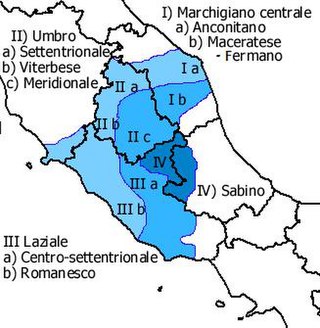This article needs additional citations for verification. (November 2008) |
Central Marchigiano refers to a group of Romance varieties spoken in the central part of the Marche region of Italy, in an area that includes the provinces of Ancona, Macerata and Fermo. It is one of the Central Italian dialects and forms part of a continuum that also encompasses Umbrian and Tuscan. There are notable grammatical, lexical and idiomatic differences between Marchigiano and standard Italian, but it is considered, along with the rest of Central Italian dialects, to be fairly intelligible to a speaker of Standard Italian.
| Marchigiano | |
|---|---|
| Marchiscià | |
| Native to | Italy |
| Region | central Marche (provinces of Ancona, Macerata and Fermo) |
Native speakers | (undated figure of 900,000[citation needed]) |
| Language codes | |
| ISO 639-3 | – |
ita-cen | |
| Glottolog | None |
| Linguasphere | & 51-AAA-rba 51-AAA-okl & 51-AAA-rba |
 | |
According to internal variation, Marchigiano is divided into two main areas:
Common features
editFeatures that distinguish Marchigiano in general from Italian include:
- Apocope in words stressed on a penultimate syllable followed by /-nV/. The equivalents of Italian contadino, piccioni, and cane ('farmer, pigeons, dog') are contadì, picció, and cà.[1]
- The presence of the ending -aro or -aru (from Latin -ārium) where Italian instead has -aio.[1]
- The fact that the general masculine singular ending in nouns and adjectives may be /u/, rather than the /o/ found in Italian.
- The vocalization of older /ʎʎ/. The equivalent to Italian figlio may be fiio, fiiu, or fio [ˈfi.o].
- The loss of /-re/ in infinitives (also found in Tuscan). The equivalents of Italian amare, mettere, and morire ('love, put, die) are amà, mette, and morì.[2]
- The change of older /ndʒ/ to /ɲɲ/, such that magnemo 'we eat' corresponds to Italian mangiamo.[2]
- Isomorphism of certain third-person plural and first-person singular verb endings, such that ama may mean either 'he/she/it loves' or 'they love'.[2]
The verbs meaning 'be' and 'have' inflect as follows in the present indicative:
| Anconitano | Maceratese | Italian | Translation |
|---|---|---|---|
| so | so | sono | I am |
| sei (sai) | ssi | sei | you are |
| è | adè | è | he/she/it is |
| semo | simo | siamo | we are |
| sé | sete | siete | you (plural) are |
| è(-ne) | adè | sono | they are |
| Anconitano | Maceratese | Italian | Translation |
|---|---|---|---|
| ciò | ciò | ho | I have |
| ciài | ci(ài) | hai | you have |
| cià | cià | ha | he/she/it has |
| ciavémo | ciaìmo | abbiamo | we have |
| ciavé | ciaéte | avete | you (plural) have |
| cià(-ne) | cià | hanno | they have |
Features of the three areas
editAncona dialect
editThe Ancona dialect is spoken only in Ancona and has only recently spread its influence elsewhere (Falconara, Osimo, Jesi, Chiaravalle, Porto Recanati, Loreto and Senigallia). Of the Marchigiano varieties, it is the one that shows the most Gallo-Italic traits. For instance, the masculine singular definite article is always el, without anything comparable to the Italian variation, according to phonetic context, between il and lo. Only the speakers from towns which are closer to Macerata (Osimo, Castelfidardo, Loreto, Porto Recanati) use the form lo as in Italian.[1] These cities also undergo other influences from the Macerata dialect, due to proximity.[1]
Fabriano dialect
editThe Fabriano dialect is spoken in Fabriano (closer to Umbria) and nearby towns. Rhotacism of /l/ occurs in this dialect, such that the local equivalents of Italian calza 'sock' and fulmine 'lightning' are carza and furmine.
Macerata dialect
editThe Macerata dialect is spoken in the provinces of Macerata and Fermo. Its speakers use lu (masculine singular) and lo (neuter singular) as definite articles. Notable features are rhotacism of /l/ and various assimilations that are absent from Italian:
| Sound change | Maceratese word | Italian counterpart | Translation |
|---|---|---|---|
| /nd/ > /nn/ | mettenno | mettendo | putting |
| /mb/ > /mm/ | gamma | gamba | leg |
| /nt/ > /nd/ | pianda | pianta | plant |
| /mp/ > /mb/ | cambu | campo | field |
| /ld/ > /ll/ | callu | caldo | hot |
Vocabulary
editThis section possibly contains original research. (September 2014) |
The following is a list of Marchigian words; note that the Anconitan forms do not show gemination[3] (babu, ciambòtu, nèrtu, etc.)
- ammò (adv. by this time; now); Anconitano: adè
- babbu (n. dad; father)
- bardasciu or vardasciu (n. boy; child); Anconitano: fiòlo
- bedollu or bidullu (n. poplar)
- brenciu or vrenciu (adj. bitter; sour)
- ciambottu or ciammottu (n. toad/clumsy)
- cuscì (adv. in this way)
- grannola (n. hail)
- (a)lluccà (vb. to shout; to scream); Anconitano: sgagià
- nnertu (adj. thick)
- rosciu or rusciu (adj. red)
- sbisgià or sbiscià (vb. to slide)
- scì (adv. yes)
- jèmmete (n. cliff)
- mata (n. mud)
See also
editExternal links
editNotes
edit- ^ a b c d Massimo Morroni, Vocabolario del dialetto osimano
- ^ a b c Carlo Grillantini, Saggi e studi sul dialetto osimano
- ^ Loporcaro, Michele (1997). "Lengthening and "raddoppiamento fonosintattico"". The Dialects of Italy. Edited by Martin Maiden, Mair Parry. Abingdon: Routledge. ISBN 0-415-11104-8.
Ancona, as claimed by Rohlfs (1966: 322) is the southernmost outcrop on the Adriatic coast - south of Wartburg's La Spezia-Rimini (or Pellegrini's Carrara-Fano) Line - of Western Romance degemination